Art World
Banksy: Artist, Activist, Agitator
Despite many attempts to unmask him, the artist remains anonymous.
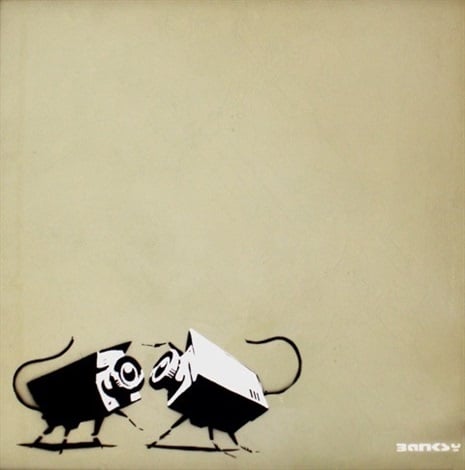
Photo: courtesy Lionel Gallery
Despite many attempts to unmask him, the artist remains anonymous.

Amah-Rose Abrams

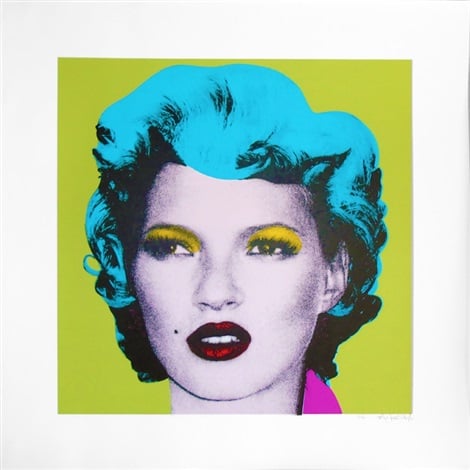
Banksy, Kate Moss (Turquoise) (2005). Courtesy of Taglialatella Galleries.
Banksy’s iconic and mysterious street art first began appearing around Bristol and London’s Shoreditch district during the mid-1990s. At the time, Shoreditch was a mass of abandoned warehouses, nightclubs, and experimental independent publishers like Dazed and Confused. It was also happened to be the epicenter of everything “cool” during the tail end of rave culture, and so when the weekend came, whole blocks would transform into wild parties. Invitations to these mass gatherings would often appear spray-painted directly onto walls and billboards, only to be gradually covered up again by the next week’s festivities.
Along with this explosion of popular music and fashion came an explosion of new art. Positioning itself against the rising tide of YBA stars like Damien Hirst and Tracey Emin, White Cube opened in Hoxton Square in 2000. The neighborhood and gallery were soon populated by creative movers and shakers, and Banksy’s artworks became an intrinsic part of that scene.
Having given up freehand graffiti at 21—ironically because he thought he wasn’t good enough—Banksy had begun making stencils giving him a strong, instantly recognizable aesthetic that stood out in the traditionally loose and gestural street art scene.

Banksy, Original CCTV (1998). Courtesy of Lionel Gallery.
His humorous, sardonic political and social commentary was the ideal wallpaper for the hedonistic and rebellious vibe of the London art scene. From kissing policemen to children floating off with used plastic bags, each Banksy piece had a very specific message it wanted to convey. The most political work from Banksy at the time was probably the army of smiley-faced soldiers that appeared at a busy junction in East London—right as the second Iraqi invasion began—boasting the dry slogan, “Have a nice day.”
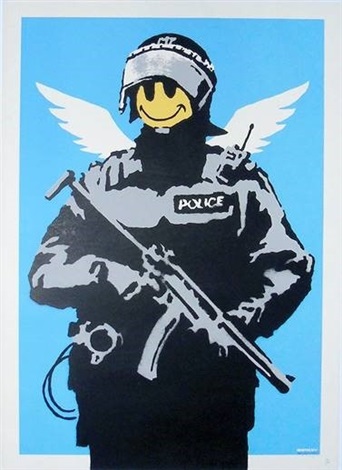
Banksy, Flying Copper (2004). Courtesy of Pop Fine Art.
Banksy‘s images were appreciated by a public often in conflict with authority, all too eager for a chance to mock the establishment while raising serious political questions. Art lovers and locals alike kept a lookout, hoping to “spot a Banksy.”
“Paul Klee said that his painting was like taking a line for a walk,” Banksy said to the Observer in 2002, while promoting his book and exhibition Existencilism. “Whereas my style is like taking a photocopier down a darkened alleyway and roughing it up.”
The following year, in 2003 Banksy staged his seminal “Turf War” project in East London, which consisted of him painting directly onto pigs and cows which—although the exhibition was granted approval by authorities—saw one animal rights protester chain herself to an animal enclosure. During that same period, Banksy also succeeded in famously hanging his own work in the Tate by smuggling the painting in under his coat.
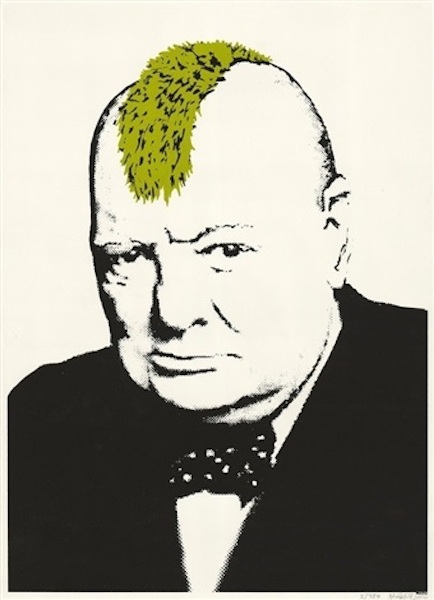
Banksy Turf War (2003). Courtesy of Joseph Fine Art.
2004 saw another public stunt by the artist, in which he tossed fake £10 notes into the crowds at the Notting Hill Carnival. The fake money—which featured the head of Princess Diana rather than the Queen of England—was soon selling for up to £200 apiece. Later that year, a limited edition poster featuring Princess Diana fetched £24,000 at auction at Bonham’s London. Banksy’s work was becoming more and more collectable, as celebrities like Brad Pitt, Angelina Jolie, and Christina Aguilera began buying his work.
In 2006, Banksy opened his first large-scale interactive installation, “Santa’s Ghetto”: a Christmas shop and exhibition on London’s Oxford Street. All the while as his work continued to sell for increasingly large amounts at auction, Banksy, ever the activist, ignored the hype and traveled to Gaza to create nine works that ran along the Israeli West Bank wall. Since then, he has also travelled to Afghanistan and Iraq, painting anti-war messages onto army tanks and throughout the cityscape.
As the price and profile of Banksy’s work rose, so did his profile as a political activist. While people were frantically tearing down walls in London to sell them as valuable artworks, Banksy took his tagging to New Orleans in the wake of hurricane Katrina.
Remarkably, despite his fame Banksy has managed to maintain not just his anonymity but also his independence, often selling his work through pop-up stalls and other temporary outlets. Those lucky enough to find one of his pop-ups are often offered highly valuable works at a knock-down price: in 2012, he sold works on Fifth Avenue in New York for $60 each. Two of these pieces have subsequently sold for $214,000.
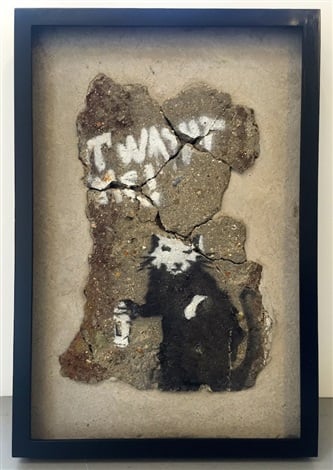
Bansky, It wasn’t me. Courtesy of MultiplesInc Projects.
During his time in New York, Banksy also tagged several buildings—many of which were quickly removed by authorities as Mayor Bloomberg unreservedly dubbed him a vandal. Several of his works in London have been similarly destroyed or painted over by local officials, often against the wishes of the property owners whose buildings they are painted on.
His latest project was also his largest to date: Dismaland Bemusement Park, located in Sommerset, England, is a decidedly misanthropic amusement park that offers visitors the chance to fully immerse themselves in a world of the artist’s own imagination. The park was highly political, with harsh commentary on the distribution of wealth, sexism, global politics, and the current UK government. When the project was over, Banksy dismantled and rebuilt the park as a camp to house refugees trapped at the border in Calais.
Whatever you many think about Banksy’s work and practice, one can’t help but be impressed that despite many attempts to unmask or de-credit him, after almost 20 years Banksy is still anonymous and still rebelling. And aren’t you the least bit curious to see he’ll do next?